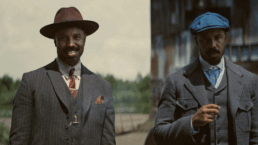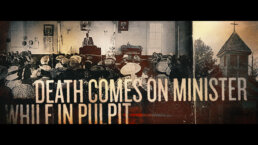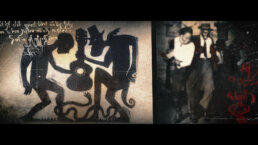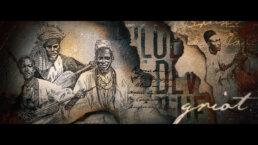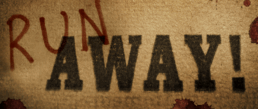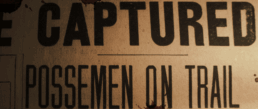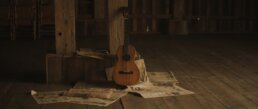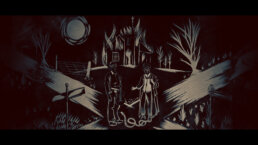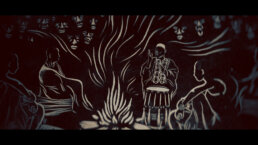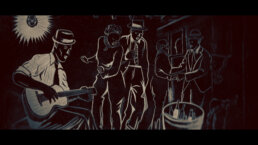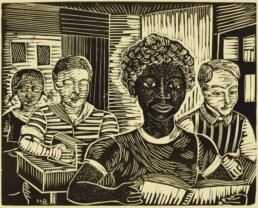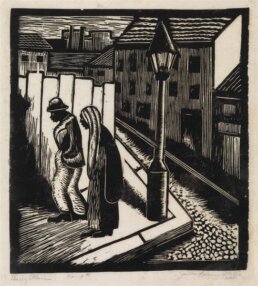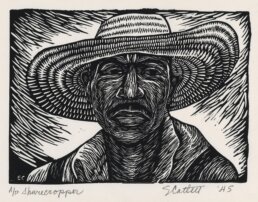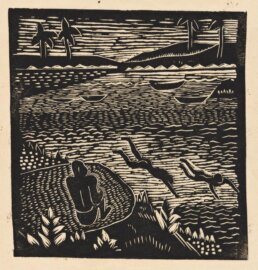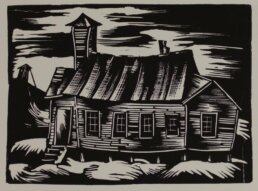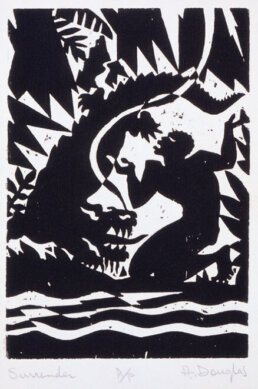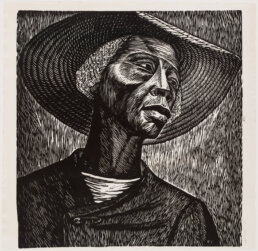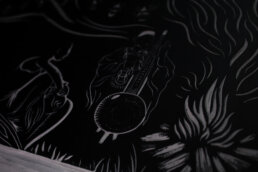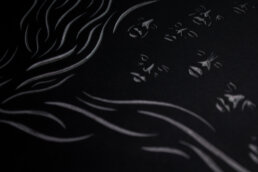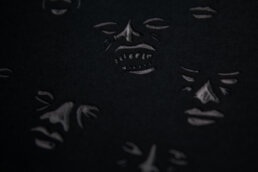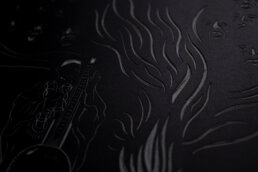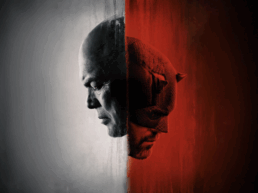01
INTRODUCTION
When director Ryan Coogler approached us to help tell the story of Sinners, a Mississippi Delta period piece that fuses the roots of blues music with the haunting mythology of vampires, we couldn’t say no. It was an invitation to build on our past collaborations (Black Panther and Wakanda Forever) and bring something bold and authentic to the screen. Tasked with crafting the film’s prologue, we designed a narrative sequence that doesn’t just set the stage, but transports audiences into its world before the story even begins.
The result is an eerie, linocut-inspired vision that fuses Southern folklore, ancestral storytelling, and vampire myth into a visual language that unsettles as much as it captivates.
02
PROLOGUE SEQUENCE
The prologue serves as a tonal prelude, a visual storybook that grounds the audience in the history, myth, and shadow of the world they’re about to enter. Much like folklore passed down through oral tradition, the sequence builds in rhythm: first with haunting stillness, then with imagery that grows darker and more supernatural as vampire myth intertwines with Southern storytelling. Throughout this progression, we wanted to foreshadow the film’s battle between ancestral memory, human frailty, and monstrous hunger, while also establishing the moral weight of the narrative.
03
VISUAL LANGUAGE
Initially, we explored a variety of handmade, grounded approaches, from filming archival materials to capturing instruments and cultural ephemera, to firmly root the audience in the 1930s. We knew the sequence needed to feel natural, scarred and imperfect, not glossy or polished.
After experimenting with these directions, we ultimately gravitated toward linocut art, drawn to its raw, hand-carved aesthetic and the sense of weight and history it seemed to easily carry. Linocut is a 20th-century printmaking technique in which artists carve directly into linoleum blocks and then press inked impressions. It was embraced for its bold contrasts, accessible, handmade quality, and connections to protest art, folk traditions, and storytelling rooted in community. While linocut can produce both the printed impression and the carved block itself, we chose to focus on the block, whose texture, depth, and shadows gave the prologue imagery that feels timeless and authentic.
The images themselves unfold like a parable:
- Folklore & Ancestry: depictions of spiritual iconography and ancestral figures establish a cultural foundation.
- History & Ritual: musical gatherings convey the traditions, practices, and community at the heart of the Delta in the 1930s.
- The Supernatural: woven into the imagery are subtle, symbolic cues that point to forces beyond the visible world. They evoke ancestral spirits and protective traditions, yet carry a darker undercurrent, hinting at rituals where the line between communion and conjuring begins to blur.
04
DESIGN PROCESS
Unlike much of our work, this sequence demanded an intimate, handcrafted feel. Sinners is bloody and gritty and grounded in the 1930's, so the sequence had to fit with the rest of the movie. Our first step was extensive research and reference gathering.
While we began our hunt online, we quickly realized we needed something more tactile. By working directly with linocut illustrator Mike Black, a.k.a. Blockforest, we could explore real textures and materials firsthand, watching how they shifted and came alive under different lighting conditions.
We then built the entire sequence digitally, giving us the flexibility to quickly iterate throughout the process. To preserve that handmade sensibility, we continued working with the linocut artist to create digital illustrations. These became the base layers for color, roughness, and bump passes. The biggest risk with a process like this is losing the physical imperfections and human touch that make it feel real, so we made that our priority. Each illustration was brought into Photoshop, where we “carved” into the artwork one stroke at a time, layering brush strokes to replicate the linocut process. These carving passes were then brought into Cinema 4D as displacement maps to create the final look.
Inside Cinema 4D, we explored camera moves, compositions, and lighting setups to dial in the right mood for the sequence. It didn’t feel appropriate to turn this into a flashy rollercoaster ride through the illustrations. Instead, we treated the sequence as though it were shot practically, keeping the camera moves restrained, while using the lighting to bring life to the illustrations.
By embracing limitations — fewer colors, slower rhythms, coarser textures — the sequence feels rooted in tradition, while still carrying the cinematic weight expected in a modern feature film.
05
SYMBOLISM AND THEMES
Every design choice reinforced the narrative’s central themes. The linocut style symbolized the endurance of memory — images carved into permanence, just as ancestral stories are etched into culture. The weathered textures reflected cycles of struggle and survival, while the stark contrasts echoed the film’s moral terrain: faith and doubt, life and death, humanity and monstrosity.
Vampire myth was woven not as fantasy, but as metaphor: a way to explore the intergenerational cost of survival, sacrifice, and sin. By embedding this language in the prologue, we gave audiences a frame for the story — not just what to fear, but why the fear exists.
06
CONCLUSION
The prologue to Sinners is more than an introduction — it’s a bridge between folklore and modern cinema, grounding the film in history and place before the first line of dialogue. We’re honored to have partnered with Ryan Coogler once again on this extraordinary project, and proud to contribute to the rich, unique world of Sinners.
